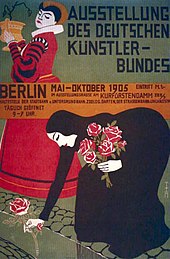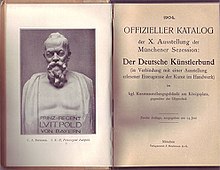German Association of Artists
The German Association of Artists was founded in Weimar in 1903 by Max Klinger , Alfred Lichtwark , Max Liebermann , Lovis Corinth , Max Slevogt and others on the initiative of the art patron Harry Graf Kessler, with significant involvement from Walter Leistikow . This was the first time that a supraregional artists' association was formed that went beyond the previous secessions. The initial motivation was the joint action against paternalism by the state art industry , with the aim of safeguarding the freedom of art , providing a forum for various art currents and promoting young artists.
history

This intention was taken into account with annual exhibitions in annually changing cities in Germany and partly also abroad. While the first exhibition in 1904 was organized as a guest appearance at the Munich Secessionists , the following year the German Association of Artists held its first own exhibition, “a comprehensive general review of the existing German forces , to inaugurate the rooms of the Berlin Secession's new exhibition center Embossed […] ”, as it is called in a contemporary review of the art chronicle .
Until the forced self-dissolution of the DKB on November 30, 1936 by the Reich Chamber of Fine Arts and the previous closure of the exhibition in Hamburg in 1936, a remarkable spectrum with a high artistic level was made accessible to a large audience in more than 20 exhibitions. Almost all artists who had a reputation in German art in the first three decades were integrated in the German Association of Artists and used the platform to develop their artistic ideas far away from state interference. The upswing and breakthrough of modernism in Germany is closely linked to the history of the German Association of Artists. The Villa Romana in Florence as a site of art, acquired in 1905 by Max Klinger on behalf of the German Association of Artists, bears witness to the great cultural and political commitment of the German Association of Artists.
Start-up
It was some former members of the German Association of Artists, such as Karl Hofer , Willi Baumeister , Charles Crodel , Karl Hartung and Karl Schmidt-Rottluff , who re-established the German Association of Artists in Berlin at the end of December 1950; to distinguish it from the first DKB, initially under the name Deutscher Künstlerbund 1950 . The first board of directors was not constituted until the beginning of 1951, and in the same year the first exhibition took place in the rooms of the University of Fine Arts in Berlin. They picked up on the tradition of an interrupted modernity, remembered the resolutions from the founding years and again campaigned for the freedom of art. Not only with the continuation of the annually recurring exhibitions, but also with numerous cultural-political initiatives, they intervened in the cultural and political life of post-war Germany.
This new beginning was not without criticism: there were large protests against Hofer's idea of an art that had to be primarily abstract after the Nazi dictatorship. Figurative artists saw themselves as wrongly ostracized, even if they worked artistically harmless in this direction. Analogous to the newly founded Federal Republic, this discourse also took place in the GDR; there under the name " formalism dispute ".
Members of the new DKB board (1951)
(Honorary President: Theodor Heuss )
- First chairman: Karl Hofer
- Second chairman: Karl Schmidt-Rottluff • Third chairman: Karl Hartung
- Secretary: Hans Kuhn • Treasurer: Adolf Hartmann
- Assessor:
Willi Baumeister, Karl Caspar , Werner Gilles , Erich Heckel , Bernhard Heiliger , Max Kaus , Karl Kluth , Gerhard Marcks , Ewald Mataré , Toni Stadler and Edwin Redslob (former Reichskunstwart until 1933)
The managing director was the art historian Eberhard Seel .
The DKB jury, which decided on prizes, grants and membership applications, included, in addition to some of the above, Curth Georg Becker , Ernst Geitlinger , Georg Meistermann , Edwin Scharff , Ernst Schumacher and Fritz Winter .
Impulses from the German Association of Artists
The German Association of Artists is one of the founding members of the Art Fund, the Verwertungsgesellschaft Bild-Kunst , the Privatinitiative Kunst (PIK), the International Society of Fine Arts (IGBK) and the Visual Arts section of the German Cultural Council . He is a supporting member of the Villa Romana in Florence. He was significantly involved in the new regulation for the Artists' Social Insurance Act and in the elaboration of the right to use works of art.
In 1974 an exhibition fee was introduced for the artists represented in his exhibitions. At the suggestion of the chairman at the time, Georg Meistermann , the federal collection was founded to promote artists and to represent the state in public space. As part of the discussion about the establishment of a German National Foundation, the German Association of Artists held a colloquium in 1978, the results of which significantly promoted the conception and construction of the art and exhibition hall in the Federal Republic of Germany . But the German Association of Artists, which in 1990 was the first institution to show a special show of GDR artists, also offered many artists a podium with its large annual exhibitions.
In 2003 the German Association of Artists celebrated its 100th anniversary as one of the oldest and most renowned artists' associations in Europe. At the same time, the associated final “annual exhibition” (at the same time the anniversary exhibition '100 Years of the Deutscher Künstlerbund') was a sign that this ritual had to be replaced in the new millennium by the regular DKB annual projects. Today it is more about the public discussion of current artistic impulses than the mere self-portrayal of the association members.
present
The German Association of Artists currently has around 750 visual artists (as of October 2019). In principle, any professional artist living in Germany can become a member, regardless of nationality. An admissions process checks the professionalism and quality of the artistic work. Participation is desirable, but not a condition for membership in the German Association of Artists. One goal of this association of visual artists is continuous content-related and self-reflective discussions of current issues in art production. The German Association of Artists represents the interests of actively working contemporary artists - and thus also the freedom and complexity of art - in relation to politics, exhibition institutions and the art market with an independent voice.
Cultural activities
Through active voluntary work in now 24 bodies, boards of trustees and committees that are involved in the drafting of legislative regulations, the German Association of Artists represents the interests of a large number of artists working in Germany. He has a seat in the expert group for art in building at the Federal Ministry for Transport, Building and Urban Development , is a member of the Federal Academy for Cultural Education Wolfenbüttel , the German Cultural Council , the Copyright Initiative, the Villa Romana in Florence. He cooperates u. a. with the Arbeitsgemeinschaft Deutscher Kunstvereine (ADKV), with the KSK Artists' Social Insurance Fund , the Art Fund Foundation , the Bild-Kunst collecting society and many other organizations relevant to cultural policy and art law. A more recent field of work is the representation of the interests of artists and art on a European level.
Projects
Since 2001 the Künstlerbund has been organizing conferences, performances and exhibitions in the project space in Berlin, to which both members and (local to international) guests are invited. The German Association of Artists also offers exhibitions, symposia and colloquia on current topics across the country. Both board members and other members of the Künstlerbund conceive and carry out voluntary work, sometimes complex artistic and cultural-political projects, which often involve many artists, art scholars and interested parties. Some projects lead to individual events, others are continued over years, some projects have a national or international effect.
Advice and information for visual artists
The German Association of Artists participates in the development of advisory instruments for artists. This includes e.g. B. Legal and organizational issues related to international travel and exhibition activities and grants (see the Touring Artists portal of the IGBK), copyright (in cooperation with VG Bild-Kunst), art in architecture / art in public spaces.
literature
- Harry Graf Kessler: The German Association of Artists . In: Art and Artists. Illustrated monthly for fine arts and applied arts , vol. 2, Berlin 1904, pp. 191–196.
- Walter Leistikow: About the German artist association and the days in Weimar . In: Art for All. Painting, sculpture, graphics, architecture , 19th year, 1903/04, issue 9, pp. 201–205.
- Art report. An overview of the German Association of Artists: 1903–1995. Special edition winter 1994/95. Deutscher Künstlerbund, Berlin 1995, ISBN 3929283085 .
- Martina Wehlte-Höschele , 1993: The German Association of Artists in the spectrum of art and cultural policy of the Wilhelminian Empire. , Dissertation at the Philosophical-Historical Faculty of the Ruprecht-Karls-Universität Heidelberg at the Art History Institute , May 11, 1994.
- Myriam Maiser, The dispute about modernity in the German Association of Artists under the first chairman Karl Hofer. An analysis of the exhibitions from 1951 to 1955, Diss. Berlin 2007.
Web links
- German Association of Artists
- Deutscher Künstlerbund in the archive of the Academy of Arts, Berlin
Individual evidence
- ↑ kuenstlerbund.de: Full members of the German Association of Artists ... since it was founded in 1903 (accessed on August 24, 2015)
- ↑ This paragraph is based on the self-presentation of the history of the Künstlerbund: Deutscher Künstlerbund - Tradition und Zukunft , Berlin 2007
- ↑ Exhibition catalog X. Exhibition of the Munich Secession: The German Association of Artists (in connection with an exhibition of exquisite products of the arts in the craft) , Verlaganstalt F. Bruckmann, Munich 1904 (73 photographic images)
- ^ Marianne Lyra-Wex: The exhibition of the German Association of Artists in the Hamburger Kunstverein in 1936. in: 1936 forbidden pictures. 34th annual exhibition Bonn , Deutscher Künstlerbund eV, Berlin 1986. (p. 19)
- ↑ Statute 1950. In: kuenstlerbund.de. Deutscher Künstlerbund eV, accessed on August 17, 2019 .
- ↑ The Art Controversy about Modernism (accessed July 25, 2016)
- ↑ spiegel.de: Rabiat like a religious war
- ^ Deutscher Künstlerbund 1950: First exhibition: August 1 - October 1, 1951 , complete production by the Hartmann brothers, Berlin 1951. Exhibition catalog (without page number)
- ↑ s. DKB exhibition catalog Herbarium of Views. New members in the German Association of Artists , rheinsatz, Cologne 2003.
